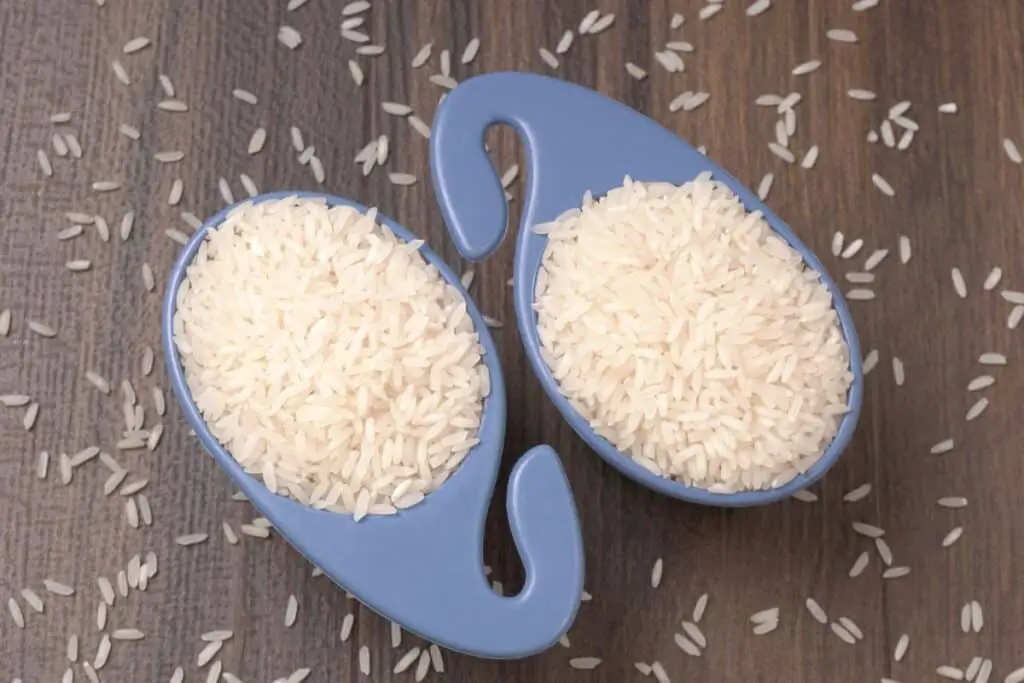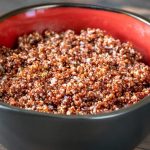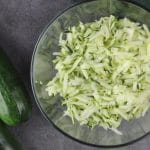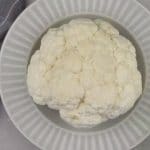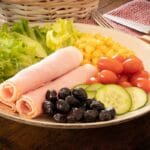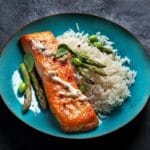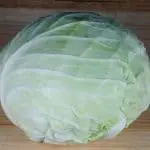Key points:
- For low-calorie and low-carb options, rice substitutes include riced cauliflower, riced broccoli, shirataki rice, zucchini rice, mushroom rice, or chopped cabbage.
- High-fiber substitutes include brown rice, bulgur wheat, farro, freekeh, and whole wheat bread.
- High-protein alternatives encompass quinoa, lentils, chickpea rice, potatoes, sweet potatoes, and corn grits.
- Additionally, couscous, barley, and orzo are highlighted as versatile alternatives.
Rice is popular worldwide in many people’s diets. It is incredibly versatile and used in so many different ways. It can be served as a cost-effective filler or side dish, turned into salads, fritters, puddings, sushi, and eaten as a main meal in dishes like egg-fried rice.
It is rare that you won’t be able to find rice at your local grocery store. However, there are many other reasons you might need a substitute.
Whether you’re following a keto or low-carb diet, trying to reduce calories, or just don’t like rice, there are numerous alternatives to try. The best rice substitute will depend on your dietary needs, budget, texture required, and the role it plays in your dish.
If you are mainly looking for a cost-effective bulking agent instead of cooked rice, you could use potatoes. However, potatoes won’t work in something like egg-fried rice or rice pudding.
In this guide, we’ll help you choose the best substitute for rice for a super tasty (and healthy) meal.
Low Calorie and Low Carb Rice Alternatives
#1. Riced Cauliflower
Cauliflower is a great low-carbohydrate and low-calorie rice alternative. It’s a good choice if you’re following a keto diet and have loads of healthy vitamins and minerals. The texture and appearance are similar to rice; it can be prepared steamed, stir-fried, or boiled.
With its rise in popularity as a healthy grain-free alternative, cauliflower rice is sold ready-packaged in many grocery stores. You can generally find it with the fresh packaged vegetables or in the frozen section.
To make your own cauliflower rice, you can either use a food processor or hand-chop the florets. Using a food processor is, however, much faster and easier.
Remove the florets from the thick stems. Place them in the food processor and pulse them for a few seconds at a time. Only pulse until they break down to resemble rice or couscous. Voila, your cauliflower rice is done!
Note that if you blend the cauliflower too long, it will become pasty. Once broken down, steam, boil, or stir fry it. Another bonus is that it cooks much faster than rice and only needs a few minutes on the heat.
This option pairs well with a variety of flavors. Fresh cauliflower rice can be eaten raw in a salad, or it can be served cooked as a seasoned side dish, with meat, poultry, fish, or pork, and used in a stir-fried ‘rice.’ The only application where cauliflower rice really is not suitable is for sweet dishes.
Of course, if you don’t like cauliflower to start with, this definitely is unsuitable and not the option for you. Unlike the very neutral taste of rice, keto rice using cauliflower has a prominent flavor that can’t be missed.
Tip: Don’t discard the stems after using the florets. These can be chopped and used in salads or as crudites. They are delicious when roasted. If you don’t mind the thicker pieces, you can add them to your rice blend.
#2. Riced Broccoli
Broccoli rice can be prepared and cooked in the same way as cauliflower rice. As with cauliflower, the taste is strong and will influence the flavor of your dish. The green color makes for a lovely pop on the plate, as long as you don’t overcook it.
This is another incredibly healthy option, rich in vitamins and minerals, low in carbs, and low in calories.
Broccoli florets can overcook very quickly and turn mushy. Keep a close eye on your broccoli rice and leave it slightly undercooked for more texture.
#3. Shirataki Rice
Shirataki rice has become a popular low-calorie alternative when replacing rice. The Asian product is also referred to as miracle rice or konjac rice. It is made from 97% water and 3% natural plant fiber from the konjac plant.
It looks very similar to rice and has a neutral taste. Shirataki soaks up other flavors well, which means it can be paired with almost any dish, sweet or savory.
Note that it cooks very quickly and can have a slightly chewy texture. One option is to blend it 50/50 with regular rice after cooking. This way, you still get the texture and flavor of rice but reduce the calories by almost half.
Shirataki noodles are another product made from konjac root and are also ideal for low-carb recipes.
#4. Zucchini Rice
Zucchini has high water content and is very low in calories and carbs. As with other green veggies, it also has great nutritional benefits.
For added fiber, leave the skin on. If this is not much of a concern, peel the zucchini and chop it into large chunks. Place these in a food processor and pulse until you get the desired size. Alternatively, chop it finely by hand.
Zucchini releases a lot of water when cooked, which can easily make it turn mushy. Although you can steam it, you will get a better texture when lightly pan-frying it, especially if you’ve chopped it very small. Larger pieces are more suitable for steaming and boiling.
When zucchini cooks, the flavor changes and becomes somewhat muted. This makes it more versatile to pair with other ingredients. It can be eaten raw, maintaining a better, firmer texture. However, many people don’t like the taste of raw zucchini.
#5. Mushroom Rice
Mushrooms are great raw or cooked and highly nutritious. They offer a meatier texture than zucchini. Their deep earthy taste pairs well with most savory dishes, which makes them a versatile and filling option.
Since a great variety of mushrooms are available, you can mix them up or use one type only. You can also combine mushrooms and zucchini as your substitute. Follow the same guidelines for making zucchini rice when making your mushroom version.
#6. Chopped Cabbage
Cabbage rice is low calorie, high fiber, and rich in vitamins and minerals. It offers a great crunch when eaten raw and is ideal if you’re trying to eat fewer carbs.
To prepare your substitute, shred the cabbage finely. You can further pulse it in a food processor until you get rice-sized pieces or simply use the longer shreds in your dish.
When cooking, you can pan fry it lightly or blanch it for just a few minutes. Remember that the smaller the pieces are, the faster they will cook.
This is a great option for salads, to serve with stews, curries, in soup, as a stir fry, and with all types of meat.
High Fiber Substitutes for Rice
All the above-mentioned low-carb options (except shirataki) are also high in dietary fiber. If you aren’t too concerned about lowering the carbs, here are some other high-fiber options that are also nutritious alternatives.
#7. Brown Rice
Brown rice is a healthier alternative to its white counterpart as it still contains bran, which aids in digestion and has added health benefits.
It has slightly more calories, but it also contains a higher level of protein and of course, fiber. This helps to regulate blood sugar levels and reduce cholesterol.
Brown rice can be used in any dish dishes as an alternative; however, for something like sushi and rice pudding, it won’t offer the same soft, fluffy, and sticky texture you are after.
It can be somewhat drier than the white version, so make sure to give it enough cooking time and add enough liquid. Since the extra fiber soaks up additional liquid during cooking, you may need to use almost twice the amount of water than you would for the more processed white grains.
#8. Bulgur Wheat
Bulgur wheat is fairly similar to brown rice in taste, texture, and the way it cooks. It offers good nutrition, fiber, and some protein. The one thing to keep in mind with this alternative is that it is a whole grain wheat product which means it is not gluten or wheat-free. Therefore, it won’t be suitable for people with wheat allergies or coeliac disease.
#9. Farro
Farro is a type of wheat and a good source of iron, fiber, and certain minerals, making it an ideal nutritional alternative. It is especially recommended as a good substitute for individuals suffering from diabetes and poor heart health.
Although it is not gluten-free, it is low-carb and suitable for people following a keto diet. Farro looks very much like whole grain wheat kernels and cooks much like brown rice with a similar texture and appearance.
#10. Freekeh
Freekeh is made from green durum wheat. It is almost identical to farro and barley in the way it looks, cooks, and its nutritional value. It has a slightly nutty flavor yet neutral taste that pairs well with most other flavors. As with the above grains, give it enough time to cook and soften before serving.
#11. Whole Wheat Bread
Whole wheat bread can make a very easy and convenient alternative if you need something to serve on the side to mop up a curry or stew. Besides the fact that it doesn’t require any cooking, it is full of fiber and contains more vitamins and minerals than white bread (or rice).
Although its uses are pretty limited in terms of how you can incorporate it as an alternative, we’re pretty sure the family won’t have a problem when their curry and rice turn into a curry sandwich instead.
High Protein Rice Substitutes
#12. Quinoa
Although quinoa looks like a grain and is prepared like a grain, it is actually a gluten-free seed. Quinoa contains all nine essential amino acids and is thus a complete protein source. It is also high in fiber and contains a small number of healthy fats.
Quinoa is a good source of carbohydrates, but unlike white rice, it has a low glycemic index which means it does not spike blood sugar levels.
To cook the seeds, place one part quinoa and two parts water in a pot. Cook over medium heat until the water is absorbed and the seeds are tender. After cooking, let it sit for five minutes before serving. You can serve this in any savory dish.
#13. Lentils
Lentils are an inexpensive and very healthy alternative. They are high in protein, fiber, vitamins, and minerals and are very filling. They also contain fewer calories than grain options.
If you are using canned lentils, make sure to drain the liquid and rinse them before seasoning or mixing them into your dish. Canned lentils are preserved in a lot of sodium. The healthier option would be to cook your own lentils, although this will take a little longer.
#14. Chickpea Rice
Like lentils, chickpeas are another very nutritious option, although they aren’t considered low in calories. They are somewhat bigger, so you’ll want to pulse them in a blender after cooking to break them into grain-sized pieces. Be aware that if you blend them too long, they will turn into a paste.
Ensure you drain all the liquid before placing them in the blender. Alternatively, just enjoy them in their whole form.
Dry chickpeas need to be soaked overnight before cooking. If you use canned chickpeas, drain off the liquid and rinse them. Do not toss the liquid (aquafaba) as this can be used as an egg white replacement in vegan dishes. It can even be whipped up, just like egg whites.
Easy Rice Replacement
#15. Potatoes
Potatoes are a great source of nutrients, including Vitamin C and fiber. Although they are carb-rich, they aren’t much different from cooked white rice when it comes to calories or protein content. Potatoes are beneficial to help maintain normal blood pressure levels.
Potatoes are versatile since you can serve them cubed, sliced, whole, stuffed, or mashed to suit your dish. To use them as a healthy substitute, avoid deep-frying them. Rather steam, bake, boil, or roast them.
#16. Sweet Potatoes
Like potatoes, sweet potato is another versatile and healthy alternative packed with nutrients. It can be cooked and used in the same way as regular potatoes. As a bonus, it can be delicious in some sweet applications as well. Since sweet potatoes are generally easy to obtain and simple to cook, this is a very convenient substitute.
#17. Corn Grits
Depending on where you live, corn grits, cornmeal, or polenta, are likely a staple in your home. This can be served as a side dish with any savory meal or prepared as a sweet porridge.
Although it is a fairly healthy alternative, it may depend on adding other ingredients and how you cook it. Cooking it in water and a pinch of salt will give you the closest replacement. However, many cooks like adding dairy, cheese, cream, milk, or butter.
#18. Couscous
Couscous comes in refined white or whole wheat couscous and is extremely easy to cook. It is not gluten-free, so keep this in mind when cooking for people with allergies. The tiny couscous balls are smaller in size than rice grains and when properly prepared have a light and fluffy texture. They have a neutral flavor and can be used as a side dish, mixed with meat or veggies, and in salads.
To prepare couscous, you simply need to cover the grains with boiling water, cover the bowl with cling film, and let it stand for 10 minutes while self-steaming. If overcooked, the couscous will turn pasty, so follow the instructions to get the right ratios and consistency.
Use a fork to fluff the grains once cooked, so they don’t clump together.
#19. Barley
Compared to many other grains, barley is high in fiber and protein. It is very similar to farro and makes for a healthy replacement. How you prepare barley will depend on the type of barley you have.
Pearl barley does not need to be soaked and has a shorter cooking time, while pot barley requires soaking and takes longer to cook. Barley can be served with stews, meat, soup, and salad.
#20. Orzo
Orzo is basically a type of pasta that is shaped like rice grains. It is a high-carb alternative but is also available in whole wheat versions, providing a good amount of fiber.
Orzo can be cooked just like pasta. Due to its small size, it will cook quickly, so be careful not to overcook it as it will become pasty. With its neutral and mild flavor, orzo can be used in any application as a substitute. You can even make orzo pudding. It is, however, not wheat- or gluten-free.
FAQs
Can I use soba or buckwheat noodles as a substitute for rice?
Yes, you can use soba or buckwheat noodles as a substitute for rice in certain dishes. They offer a different texture and flavor profile compared to rice, but they can work well as an alternative in recipes where the change in texture is acceptable.
What can I use instead of sushi rice?
You can use alternatives like quinoa, cauliflower rice, or brown rice as a substitute for sushi rice in your sushi preparations.
What are the best rice substitutes for diabetics?
For diabetics, ideal rice substitutes include cauliflower rice, quinoa, and brown rice due to their lower glycemic index and higher nutritional value, helping to manage blood sugar levels more effectively.
Conclusion
There is a wide range of rice substitutes available for every diet type. Whether you are looking for a similar option in appearance, flavor, and texture, or something with higher protein and fewer carbs, there’s a perfect fit to meet your needs.
When choosing the most suitable substitute, you want to check how the flavor profile of your dish may change. This specifically applies to using non-grain alternatives like broccoli and cabbage.
Even if you don’t necessarily need a substitute, play around and try something new. You might find a new favorite way to enjoy an old classic recipe.
See more:
*image by rakshashelare/depositphotos
